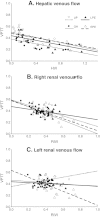Maternal venous hemodynamics in gestational hypertension and preeclampsia
- PMID: 24957330
- PMCID: PMC4090345
- DOI: 10.1186/1471-2393-14-212
Maternal venous hemodynamics in gestational hypertension and preeclampsia
Abstract
Background: To evaluate characteristics of venous hemodynamics, together with cardiac and arterial function, in uncomplicated pregnancies (UP), non-proteinuric gestational hypertension (GH) and preeclampsia (PE).
Methods: In this observational cross-sectional study, venous hemodynamics was assessed using a standardised protocol for combined electrocardiogram (ECG)-Doppler ultrasonography, together with a non-invasive standardised cardiovascular assessment using impedance cardiography (ICG) in 13 women with UP, 21 with GH, 34 with late onset PE ≥ 34 w (LPE) and 22 with early onset PE < 34 w (EPE). ECG-Doppler parameters were impedance index at the level of hepatic veins (HVI) and renal interlobar veins (RIVI) together with venous pulse transit times (VPTT), as well as resistive and pulsatility index, and arterial pulse transit time (APTT) at the level of uterine arcuate arteries. ICG parameters were aortic flow velocity index (VI), acceleration index (ACI) and thoracic fluid content. Mann Whitney U-test, Kruskall-Wallis test and linear regression analysis with heteroskedastic variance was used for statistical analysis.
Results: RIVI in both kidneys was >15% higher (P ≤ .010) in LPE and EPE, as compared to GH and UP. Next to this, >30% lower values for VI and ACI (P ≤ .029), and > 15% lower values for APTT (P ≤ .012) were found in GH, LPE and EPE, as compared to GH.
Conclusion: In comparison to UP, similar abnormalities of central arterial function and APTT were found in GH, EPE and LPE. Proteinuria of LPE and EPE was associated with increased RIVI, this was not observed in GH.
Figures


References
-
- Carbillon L, Uzan M, Uzan S. Pregnancy, vascular tone, and maternal hemodynamics: a crucial adaptation. Obstet Gynecol Surv. 2000;55(9):574–581. - PubMed
-
- Hausvater A, Giannone T, Sandoval YH, Doonan RJ, Antonopoulos CN, Matsoukis IL, Petridou ET, Daskalopoulou SS. The association between preeclampsia and arterial stiffness. J Hypertens. 2012;30(1):17–33. - PubMed
-
- Cnossen JS, Morris RK, ter Riet G, Mol BW, van der Post JA, Coomarasamy A, Zwinderman AH, Robson SC, Bindels PJ, Kleijnen J, Khan KS. Use of uterine artery Doppler ultrasonography to predict pre-eclampsia and intrauterine growth restriction: a systematic review and bivariable meta-analysis. CMAJ. 2008;178(6):701–711. - PMC - PubMed
-
- Melchiorre K, Sharma R, Thilaganathan B. Cardiac structure and function in normal pregnancy. Curr Opin Obstet Gynecol. 2012;24(6):413–421. - PubMed
Publication types
MeSH terms
Substances
LinkOut - more resources
Full Text Sources
Other Literature Sources

